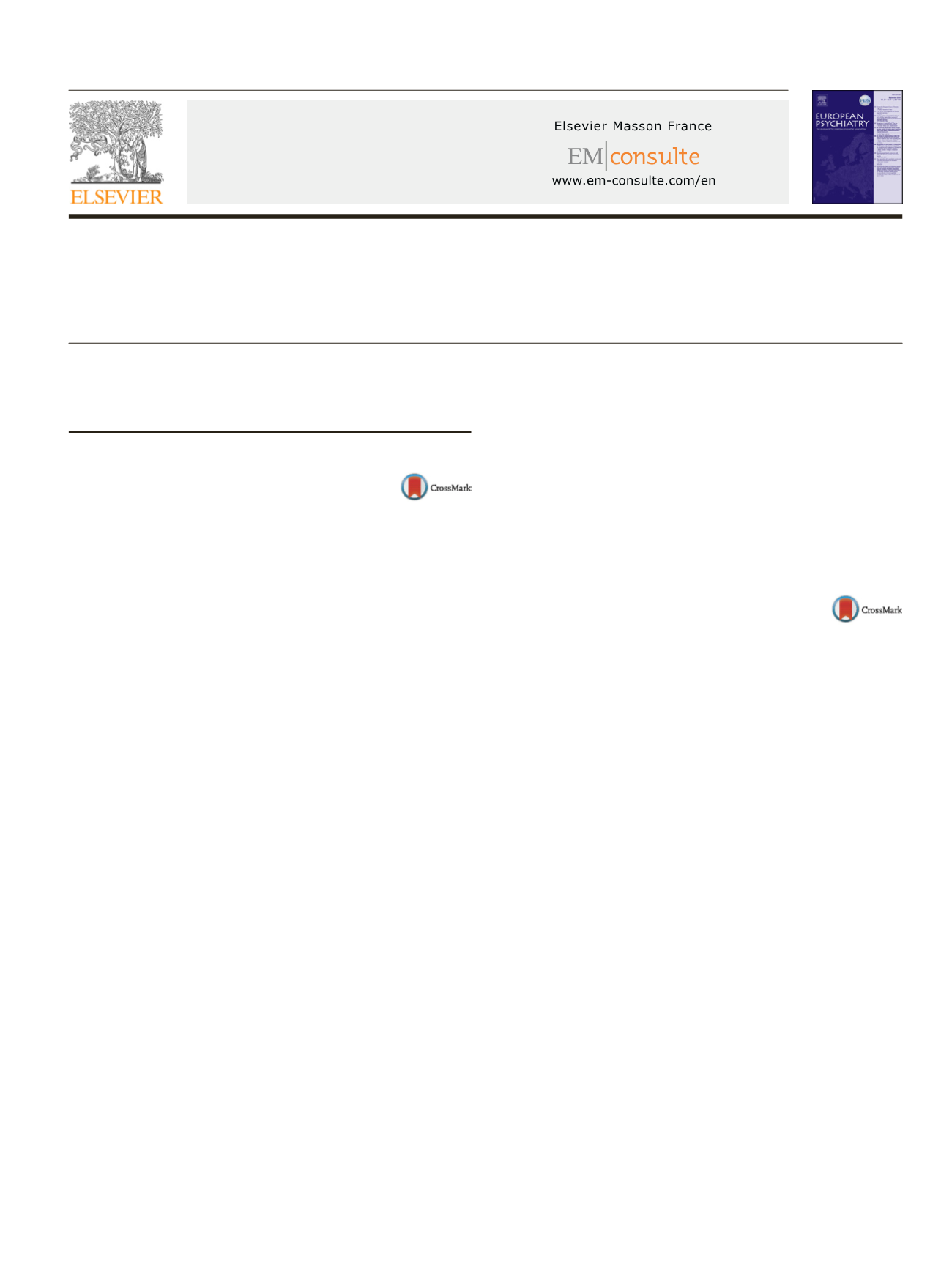
 European Psychiatry 41S (2017) S521–S582
European Psychiatry 41S (2017) S521–S582
Available online at
ScienceDirect
www.sciencedirect.com25th European Congress of Psychiatry
ePoster viewing part 3
e-Poster Viewing: Depression
EV0360
Global arginine bioavailability ratio is
decreased in patients with major
depressive disorder
T. Ali-Sisto
1, T. Tolmunen
1 , 2, H. Viinamäki
1 , 2, P. Mäntyselkä
3 , 4,
V. Velagapudi
5, L. Soili
1 , 2 ,∗
1
University of Eastern Finland, Institute of Clinical Medicine, Kuopio,
Finland
2
Kuopio University Hospital, Department of psychiatry, Kuopio,
Finland
3
University of Eastern Finland, Primary Health Care Unit, Kuopio,
Finland
4
Kuopio University Hospital, Primary Health Care Unit, Kuopio,
Finland
5
Institute for Molecular Medicine Finland, Metabolomics unit,
Helsinki, Finland
∗
Corresponding author.
Introduction
The global arginine bioavailability ratio (GABR) is
used to estimate arginine supply. Arginine is precursor to nitric
oxide (NO) that has been suggested to play a role in major
depressive disorder (MDD). NO also participates in neuronal,
inflammatory and cardioprotective functions.
Objectives
To compare GABR between:
– D patients and non-depressed controls;
– remitted and non-remitted MDD patients;
– baseline and follow-up within remitted and non-remitted MDD
groups.
Aims
To investigate the role of NO production in MDD.
Methods
The sample comprised 99 MDD patients and 253 non-
depressed controls (Beck Depression Inventory scores < 10) aged
20–71 years. Altogether, 78 patients returned for the follow-up;
33 were remitted and 45 non-remitted. GABR was calculated from
serum levels of arginine, citrulline and ornithine, which were ana-
lysed using ultra-performance liquid chromatography. Differences
between the study groups were examined using logistic regression
adjusted for age, gender, smoking, alcohol use, physical exercise
and glycated haemoglobin. The follow-up regression analyses were
adjusted for age, gender and physical exercise.
Results
Lowered GABR was associated with belonging to the
MDD group (OR 0.13, 95% CI 0.03–0.50). Exclusion of partici-
pants using anti-depressants that were associated with measured
metabolites did not change the results. Over the follow-up period,
the remitted and non-remitted groups both showed an increase in
GABR (
Z
= –.53,
P
< 0.001 and
Z
= –3.00,
P
= 0.003, respectively).
Conclusions
Decreased GABR may characterise MDD. This could
affect neuronal, immunological and cardioprotective functions of
NO.
Disclosure of interest
The authors have not supplied their decla-
ration of competing interest.
http://dx.doi.org/10.1016/j.eurpsy.2017.01.690EV0361
Depression and multiple
sclerosis–pathophysiological links:
From biology to treatment
S.L. Azevedo Pinto
∗
, R. Coelho , A. Silva
Hospital de S. João, Clínica de Psiquiatria e Saúde Mental, Porto,
Portugal
∗
Corresponding author.
Introduction
Depressive disorders (DD) are the second cause
of disability worldwide. DD affect predominantly working age
individuals, recurring in 75% of cases. DD pathophysiology is intri-
cate and multi-factorial. Several inflammatory diseases have been
linked to mood disorders. Amidst these conditions is multiple scle-
rosis (MS), a chronic inflammatory disease of the central nervous
system, characterized by frequent exacerbations and progressive
functional loss.
Objective
To review the current knowledge on DD and MS as
comorbidities and the underlying pathophysiologic mechanisms.
Methods
We performed a bibliographic search in Pubmed–
publications released in the last 5 years, written in English,
Portuguese and Spanish, containing the keywords depression,
inflammatory disorders, multiple sclerosis.
Results
The inflammatory hypothesis of depression provides a
strong foundation to explain its close link with multiple sclero-
sis. The incidence and prevalence of DD is significantly higher in
MS, especially in men. Functional imaging studies have shown that
depressive symptoms are closely linked to the extension of inflam-
matory lesions, especially on the frontal and parietal regions, with
particular emphasis to those affecting the grey matter. On the one
hand, the clinical course and response to treatment of MS may be
hinderedbyDD; on the other hand, the evolutionofMS lesions leads
to fluctuations in mood, with significant improvement of DD with
successful MS treatment, independently of physical improvement.
0924-9338/


















